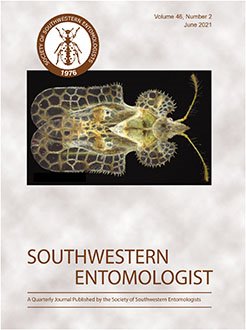Miriam Sánchez-Vega, Luis Alberto Aguirre-Uribe, Mariano Flores-Dávila, Ernesto Cerna-Chávez, Yisa María Ochoa-Fuentes, Agustín Hernández-Juárez, Alonso Méndez-López
Southwestern Entomologist 46 (2), 317-330, (29 June 2021) https://doi.org/10.3958/059.046.0203
Reduction in pests targeted by Bt cotton is widely studied; however, other phytophages not affected by Bt cotton-expressed toxins are increasing, suggesting these potential pests might occupy ecological niches of primary pests and become new key pests requiring use of broad-spectrum insecticide. During the 2017 spring-summer crop season, insects were collected on 10 genetically modified (GM) hybrids of cotton (Gossypium hirsutum L.), planted at “Rincón del Buitre” ranch, belonging to “Universidad Autonoma Agraria Antonio Narro” (UAAAN) at San Pedro, Coahuila, Mexico. The 13,422 phytophagous insects collected from GM cotton were in five orders: Coleoptera, Diptera, Hemiptera, Lepidoptera, and Thysanoptera; ≈12,766 of the individual insects were in Hemiptera, mainly whiteflies (Aleyrodidae), for a total of 657 other insects collected. Coleoptera were 18.5% of the families, 19.4% of species, and 6.6% of individuals; Diptera had 29.6, 27.8, and 17.2%, respectively; Hemiptera (without Aleyrodidae) had 25.9, 27.8, and 18.9%, respectively; Lepidoptera had 18.5, 19.4, and 44.6%, respectively, and Thysanoptera had 3.7, 2.8, and 2.5%, respectively. Species with more individuals than 5% of the total were Anagasta kuehniella Zeller (32.7%), Spodoptera exigua Hübner (11.0%), Epichlorops sp. Becker (10.7%), Lygus oblineatus Say (9.0%), Diabrotica balteata Leconte (6.9%), Anthonomus grandis Boheman (5.9%), and Bemisia tabaci Gennadius (≈12,766 individuals). Species with greatest incidence among cotton hybrids were Epichlorops sp. (70%), L. oblineatus and D. balteata (each 60%), and A. grandis and Aphis gossypii Glover (each 30%). Monitoring increasing abundance of secondary pests on Bt crops can indicate if the pests threaten sustainable production of the crop.

